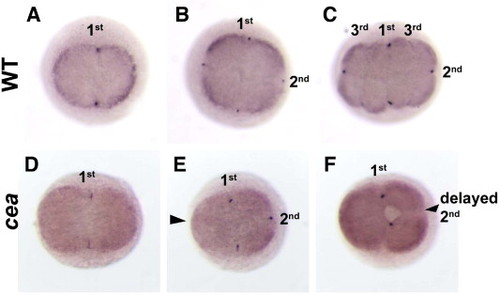Fig. 9
- ID
- ZDB-FIG-071223-8
- Publication
- Yabe et al., 2007 - The zebrafish maternal-effect gene cellular atoll encodes the centriolar component sas-6 and defects in its paternal function promote whole genome duplication
- Other Figures
- All Figure Page
- Back to All Figure Page
|
Germ plasm recruitment fails after a one-cycle delay and cleavage resumption. In situ hybridization to label vasa mRNA in wild-type (A–C) and maternally mutant cea embryos (D–F) at the 45 min p.f. (2-cell in wild-type; A, D), 1 h p.f. (4-cell in wild-type; B, E) and 1.25 h p.f. (8-cell in wild-type; C, F). In wild-type embryos, germ plasm accumulates at the furrows of the first and second cell divisions (A, B), but not for the third cell division (C). In mutant embryos, germ plasm accumulates normally in the furrow of the first cell division (D), but fails to accumulate in both furrows that do not form in the second cell cycle (E, arrowhead) and furrows that form after a one-cycle delay of the second cleavage division (F, arrowhead). 1st, 2nd and 3rd indicate the cleavage furrows of the first, second and third cleavage cycle. |
Reprinted from Developmental Biology, 312(1), Yabe, T., Ge, X., and Pelegri, F., The zebrafish maternal-effect gene cellular atoll encodes the centriolar component sas-6 and defects in its paternal function promote whole genome duplication, 44-60, Copyright (2007) with permission from Elsevier. Full text @ Dev. Biol.

